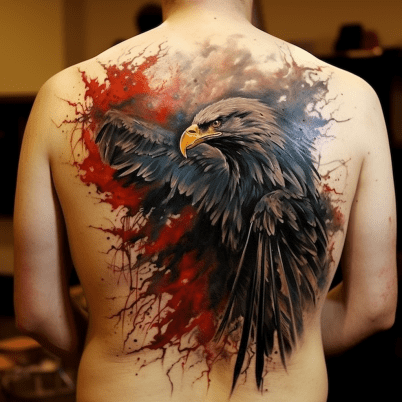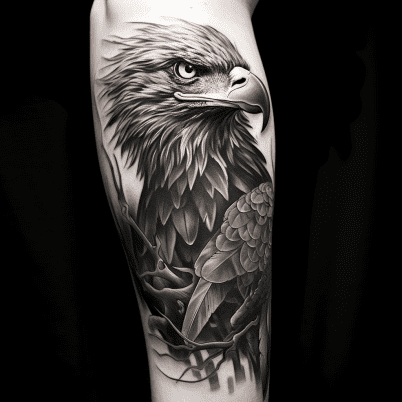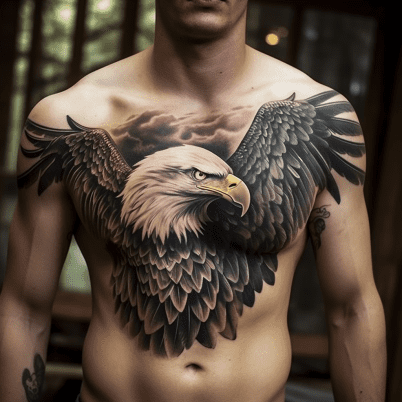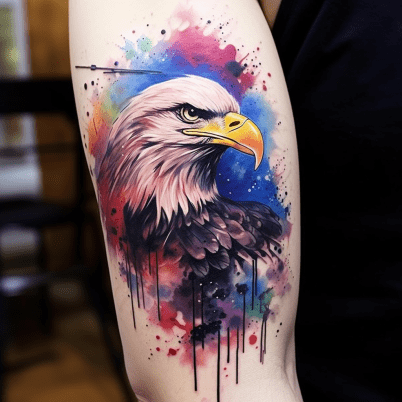In the ever-evolving world of body art, tattoos serve as a canvas for individuals to showcase their stories, beliefs, and passions. Among the myriad of designs available, the majestic eagle has long held a place of reverence. Its symbolism transcends cultures, resonating deeply with themes of freedom, strength, and vision. For those seeking a more discreet yes equally powerful statement, side neck tattoos for men have risen in popularity, offering a unique placement that draws intrigue and admiration. And when it comes to choosing designs that exude both allure and danger, snake tattoos are unmatched in their ability to blend ancient symbolism with modern style. Join us as we delve into the captivating realm of eagle tattoos, exploring their rich history and significance while also touching upon other favored designs of the present era.
History of Eagle Tattoos
The eagle, with its majestic wings and piercing eyes, has been a revered symbol in many cultures for millennia. Its representation in body art, particularly tattoos, has a rich history that spans across continents, cultures, and ages. Here, we explore the origins and evolution of eagle tattoos and their notable mentions among ancient societies and tribes.
Several ancient societies held the eagle in high regard, often attributing divine or royal connotations to it.
- Mesopotamia: The ancient Sumerians had a deity named Anzu, depicted as a massive bird, sometimes resembling an eagle, representing both the southern wind and the thunder clouds. This deity was later absorbed into the pantheons of the Akkadians, Babylonians, and Assyrians.
- Rome: The eagle was the emblem of the Roman legions, symbolizing strength and courage. It was not uncommon for Roman soldiers to have tattoos or wear amulets bearing the eagle’s likeness to channel its fierce energy in battle.
- Nordic Cultures: In Norse mythology, an unnamed eagle sits at the top of the World Tree, Yggdrasil, and is said to have knowledge of many things. Its imagery, though not extensively, has been found in Viking artifacts and carvings.
- Native American Tribes: Different tribes had varying beliefs surrounding the eagle. The Plains Indians, for instance, believed that the eagle had a special connection with the heavens since it flew so close to the sky. Eagles’ feathers were thus seen as sacred and were used in various tribal ceremonies. Tattoos or body paints depicting the eagle were seen as spiritually elevating and were often worn by tribal leaders or shamans.

Symbolism of the Eagle
The eagle, with its vast wingspan, keen eyes, and soaring flights, has captivated human imagination for centuries. It’s more than just a bird; it’s a symbol that carries profound meanings across different cultures and religions. Let’s delve into the multifaceted symbolism of the eagle.
Freedom and Independence:
Arguably the most universal interpretation of the eagle is its embodiment of freedom. Soaring high above mountains and plains, the eagle seems unbound and unrestricted by the terrestrial world. It epitomizes the spirit of independence, representing a creature that lives on its terms, unhindered by any barriers. This association is perhaps why many countries, including the United States, have adopted the eagle as a national symbol, representing the ethos of liberty and self-determination.
Strength and Power:
The eagle’s prowess in hunting and its dominant presence in the skies is a testament to its raw strength and power. In various cultures, the eagle is popular as a symbol of victory, might, and dominance. Ancient Romans, for instance, viewed the eagle as a sacred emblem of Jupiter, the god of the sky, thunder, and lightning, reinforcing its association with strength. In warrior cultures, eagle motifs might be donned to invoke the bird’s ferocious spirit and courage in battle.
Vision and Clarity:
With eyes that can spot a prey from miles away, the eagle is often linked to vision, both literal and metaphorical. It symbolizes clarity, perspective, and insight. The idiom “eagle-eyed” encapsulates this idea of keen observation and attention to detail. On a more symbolic level, it also represents the ability to see beyond the obvious, discerning deeper truths and gaining a broader perspective on life.

Popular Styles and Variations
Tattoo artistry is as diverse as the myriad of human expressions, and the eagle, being a universally revered symbol, fits seamlessly into many of these styles. Here’s a closer look at popular styles and variations for eagle tattoos:
Traditional and Neo-traditional:
- Traditional: This roots in the tattoo culture of the early 20th century, particularly within the naval and maritime communities. This traditional style has bold lines, solid colors, and iconic symbols, including anchors, swallows, and of course, eagles.
- Neo-traditional: This is an evolution of the traditional style, incorporating more varied color palettes, intricate shading, and a broader range of motifs. Pair eagles in this with vibrant roses or other contemporary symbols.
Realistic and Portrait Style:
Offering a lifelike representation, this style captures the minute details of the eagle’s features. Portrait style eagle tattoos often feel like photographs inked onto the skin, showcasing the artist’s precision and skill.
Tribal and Blackwork:
- Tribal: Rooted in indigenous cultures, tribal tattoos use bold black patterns and designs. An eagle in this style would be abstracted into these patterns, yet retain its recognizable form.
- Blackwork: This style focuses on large black inked areas. An eagle in a blackwork style might focus on its silhouette or use heavy black shading to emphasize particular features.
Geometric and Abstract:
These tattoos break down the eagle’s form into shapes and patterns. A geometric eagle has triangles and polygons, while an abstract variation could play with form and color to evoke the essence of the bird rather than a lifelike representation.
Watercolor and Brush-stroke Styles:
- Watercolor: Mimicking the fluidity of watercolor paintings, these tattoos use soft color transitions, splatters, and drips. An eagle in this style would appear as if painted onto the skin, with vibrant colors blending into each other.
- Brush-stroke: This style emulates brush strokes of traditional painting. The rough, textured look gives the eagle a dynamic and artistic appearance.

Placement Ideas:
Where you choose to place your eagle tattoo can enhance its meaning and visual impact. Here are some popular placement suggestions:
- Chest and Back Pieces: The expansive canvas of the chest and back allows for larger, detailed designs. An eagle spanning across the back or chest gives it a majestic and dominant presence.
- Arm and Forearm Sleeves: Perfect for designs that wrap around, you can coil an eagle around the arm or be part of a larger thematic sleeve incorporating other symbols.
- Leg and Calf Tattoos: These areas offer another spacious canvas. Whether it’s a soaring eagle on the thigh or a perched one on the calf, these placements are both eye-catching and easily concealable if needed.
- Small Symbolic Tattoos: For those wanting a more discreet homage to the eagle, place smaller designs on wrists, ankles, or even behind the ear. These can be minimalist representations or just the eagle’s key features, like its eyes or talons.

Tips for Choosing the Perfect Eagle Tattoo
An eagle tattoo is not just an art piece on your skin; it’s a personal emblem, a testament to your beliefs, inspirations, or memories. Therefore, selecting the ideal design and ensuring it stands the test of time is essential. Here are some pointers to help you in this endeavor:
- Before settling on a tattoo artist, look at their portfolios, especially any previous eagle tattoos or designs in the style you desire.
- Consider feedback from previous clients and perhaps seek recommendations from friends or acquaintances.
- Think about what the eagle symbolizes for you. Is it freedom, resilience, or a personal memory? Integrate elements that resonate with your narrative.
- Add elements or twists that make the tattoo uniquely yours. This could be a particular accessory on the eagle, a background element, or even a quote.

Aftercare and Longevity
Ensuring your eagle tattoo remains as majestic as the day you got it is crucial:
- Prolonged sun exposure can fade tattoos. Use sunscreen or protective clothing to shield your tattoo from UV rays.
- Keep the skin hydrated to maintain the tattoo’s vibrancy.
- Follow the artist’s aftercare instructions diligently. Typically, this includes keeping the tattoo clean and avoiding submersion in water.
- As the tattoo heals, it may itch. Scratching can damage it, so instead, apply a recommended moisturizer.
- Over time, some areas might fade more than others. Schedule touch-ups if needed to keep the design fresh and vibrant.

Conclusion
The eagle, with its potent symbolism and stunning aesthetics, makes for an impactful tattoo. Its allure lies not just in its beauty but also in the depth of meaning it carries. As you embark on the journey of getting an eagle tattoo, remember to embrace both its symbolism and the artistry it entails. Each design decision, from size to color to placement, should resonate with what the eagle represents to you personally. After all, tattoos are more than just ink on skin; they’re stories, beliefs, and memories that we choose to carry with us, etched forever in the canvas of our bodies.

